|
Lautard's Strokagenius
Lowbed Tablesaw Dolly
By Guy Lautard
https://www.lautard.com/
2570 Rosebery Avenue
West Vancouver, B.C.
CANADA V7V 2Z9
My woodwork shop is quite limited in size, so my
bandsaw, tablesaw and jointer all have to be mobile. The first
camel to stick its nose into the tent was the bandsaw, and it
was soon perched on a castered stand which is described in my
book, "The
Machinists Third Bedside Reader".
The tablesaw came next, in '94. Again, it had to be mobile. Not
liking the price of ready-made steel dollys, I made a lowbed dolly
for it using wood on hand, four casters and a few bolts. When
you've had a look at the drawing below, I think you will forgive
me for thinking my lowbed dolly design is rather clever.

It is unlike anything I have ever seen illustrated in Fine
Woodworking Magazine or elsewhere. It is easy to make, and
it works well.

In spite of the fact that the first one used 3" diameter
casters, it raised the saw only about 1-½" off the
floor. The dolly allowed me to roll the saw out for use, or up
against the wall for storage.
However, it wasn't always easy to push around. If the saw, which
weighs about 400 lbs., sat in one spot for several days or weeks,
the rubber casters would develop a pronounced flat spot. When
I wanted to move it, it required quite a pull to get it moving,
and would go lump-lump-lump across the floor like a frog with
a wooden leg, with a noticeable clanking noise.
About 5 years ago I rebuilt the tablesaw dolly, using new Guitel
4" Resilex casters. These are markedly superior to the regular
hard black rubber wheeled casters I used originally.
I came across these Resilex casters at an Industrial Show here
in Vancouver in September '99. Much impressed by what I saw and
heard, I subsequently ordered 8 of their 4" locking swiveling
casters, with a view to rebuilding both my tablesaw and jointer
dollys.
I had different reasons for wanting to rebuild each of these
dollys. As already indicated, the tablesaw can be difficult to
maneuver on the hard rubber casters I used originally. The jointer,
on the other hand, moves too easily, perhaps because it weighs
much less - about 200 lbs., I would guess. The problem with the
jointer was to keep it from moving across the shop while I was
trying to put wood over it.
The Guitel rep told me their Resilex casters start, roll, and
pivot with half the effort of regular rubber wheeled casters.
The Resilex wheel material has excellent memory for its original
shape, so if the casters sit under a load that is within their
rated capacity, even for several months, the moment you move the
wheel, the flat spot disappears! He also told me they are quiet,
will readily roll over small debris (say up to about 5% of wheel
diameter) on the shop floor, and will not pick up or embed that
debris in themselves.
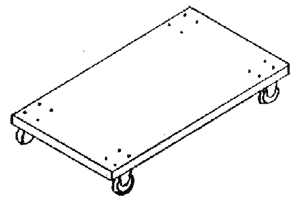
A typical dolly - just a plywood deck on
casters
From what I've seen, they seem to be as good as the Guitel guy
told me. Before I took the saw off the dolly with the hard rubber
wheeled casters, I put a bathroom scale between my bellybutton
and the saw, and pushed, while my wife read the scale from the
opposite side of the saw. We got readings from 20 to 50 lbs. before
the saw would move.
When I finished the new dolly, with the Guitel casters, and got
the saw onto it, I repeated the above test. The readings were
then 10 to 20 lbs.
Now I ain't runnin' no sophisticated testing lab here, but my
simple test does provide some specific numbers to back up what
I could tell immediately when I tried to move the saw about on
its new dolly - it is a LOT easier to move.
Apparently these casters will also roll over electrical cords
with ease. I would regard that as a lousy way to treat an electrical
cord, and since I'm the guy who pays for electrical cords around
here, I don't plan to try it "in the interests of science."
However, after I rebuilt the jointer dolly, I did find that I
could roll the jointer over a 3/4" thick rubber anti-fatigue
mat with little difficulty. Trying the same thing with the tablesaw
showed that it can be done, but it is a struggle, and would probably
be hard on the mat, if done repeatedly. Solution? Move the mat.
----------
As noted above, my tablesaw weighs about 400 lbs. Several years
ago, when I finished the first lowbed dolly I made for it, I spent
most of that night worrying and scheming about how to get the
saw onto the dolly.
The next morning I went down to the shop, tipped the saw towards
the motor side, and pushed the dolly about half way under the
saw's steel cabinet base with my spare foot. I then pulled, twisted,
and wrestled the saw the rest of the way onto the dolly. I was
amazed at how easy it was to do***. I didn't time myself, but
I don't think it took 3 minutes.
*** PLEASE NOTE
THE FOLLOWING:
It would be only slightly LESS easy
to have the saw go right over on its side with a most sickening
smash, so if you try this, BE CAREFUL.
The smallest size Resilex casters available are 4" in diameter,
so that's what I got for both dollys. In Guitel's medium duty
frame, just one 4" Resilex caster will take a 330 lb. load,
so both my dollys, with four such casters, are considerably overbuilt
in the caster department, but that is not a bad thing.
The Resilex swiveling casters can be ordered with a brake mechanism
if desired. The brake locks out both wheel rotation and caster
rotation simply by stepping on a toe pedal. And when you lock
the casters, the saw is definitely "parked."
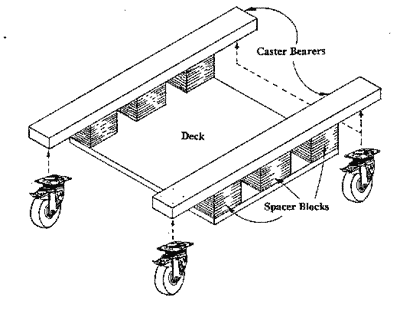
Now you may be wondering, "What about your jointer dolly?
How did that work out?"
Answer: It also works good. It rolls around the shop with ease,
but when the brakes are on, the jointer does not go rolling away
from me when I'm trying to put stock over it.
I mentioned that the saw dolly is overbuilt. This is even more
so for the jointer dolly, in terms of the actual load vs. what
the casters could carry.
Originally, both dollys were given locking swivel casters all
the way around. Subsequent experience has shown me that two locking
swivel casters per dolly is fine in my shop. I still have 4 locking
casters on the table saw dolly.
On the saw dolly, when two caster brakes are locked, the saw
seems pretty well anchored in one spot. I guess the saw is heavy
enough that the locked casters are not going to slide on the battleship
linoleum tiles in the wood shop.
I initially found that with only 2 brakes locked, the jointer
could, with some effort, still be made to move somewhat on that
same linoleum tiled floor. Eventually, however, I swiped 2 of
the 4 locking swivel casters off the jointer dolly, and replaced
them with plain swiveling casters. While the jointer can move
when I am running wood over it, this rarely occurs, and a scrap
of wood to block one or both of the non braked wheels would solve
the problem if it did arise.
(The two locking swivel casters were combined with two plain
swiveling casters on a new dolly for the bandsaw stand.)
Another point:
"How many swiveling casters should one put on a dolly?"
I don't have a definite answer to this question, and I'm not
sure that there is one, but I will tell you my own thinking.
If a dolly or trolley is going to be towed, e.g. through a factory
behind a garden tractor or similar, I suspect that two fixed casters
at the back end and two swiveling casters at the front is the
most practical wheel arrangement. (Which is prolly why cars are
made that way, eh?) I'm not sure if the tongue, or tow bar, should
be pivoted to swing in the horizontal plane or not - I suspect
this depends on the length of the tongue. I think the tongue likely
should be able to be attached in such a way as to have at least
some up and down freedom.
The same arrangement may be ok for a dolly that is being pushed
and pulled by a person, either with hands placed on the load,
or via a rope attached to the two front corners of the dolly,
such as you sometimes see on furniture movers' dollys.
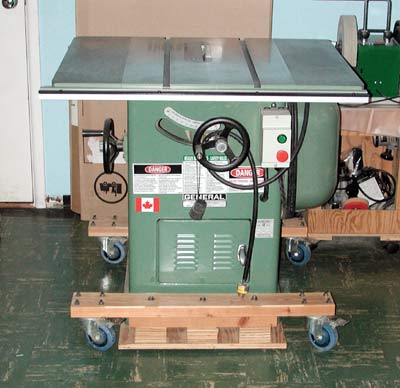
However, FOR MAXIMUM MANEUVERABILITY, I think swiveling casters
all around is the best way to go.
With my machines – tablesaw, jointer, bandsaw – I
find I often want to spin the machine around within its own footprint,
either to suit whatever work I'm about to put over it, or simply
when moving it to whatever location I may want, in order to get
it out of the way. In such cases, swiveling casters all around
is definitely the best arrangement. At least 2 of the 4 swiveling
casters should have brakes.
Using swiveling casters all around costs a little more than using
2 swiveling and 2 fixed casters. But you're going to be dealing
with the maneuverability of the dolly you put them on for many
years, long after a few dollars spent or saved will have ceased
to matter at all.
----------
I was so impressed with these casters that I have arranged to
stock and sell them, because I figured other guys besides me would
have lots of uses for such dollys. See my website
for more details.
Costs:
If you go to a good hardware store, you will likely find that
the price for Guitel casters is little if any higher than what
you will pay for regular hard rubber casters of the same size.
And note that the latter, even in the 4" size, are typically
only capable of handling a 225 lb. load. Guitels will handle 330
lbs per caster, or 440 lbs with a heavier duty frame.
TWO FINAL NOTES:
1. Most Resilex casters have blue wheels. And you will recall
I said they were superior to common hard rubber wheels, had less
rolling, starting and pivoting resistance, and did not allow shop
debris to embed in the tread of the wheel.
Now, here is something really hilarious: Other caster manufacturers
are now making casters with blue wheels. They pick up shop debris,
won't take the same loads, can't match the low starting, rolling,
and pivoting resistance of Guitels... but they are the same color.
One would wonder why they'd want to make blue wheels, just like
Guitel, when they can't match their performance? Well, you know
the old saying: "Imitation is the sincerest form of flattery."
2. And finally, a WARNING: Resilex casters can lead to workplace
violence. If you have a fleet of dollys in a factory situation,
and then provide one new dolly equipped with Resilex casters,
workers may well fight over who gets to use it.
Of course, the solution to that one is obvious:
Buy more Resilex casters!
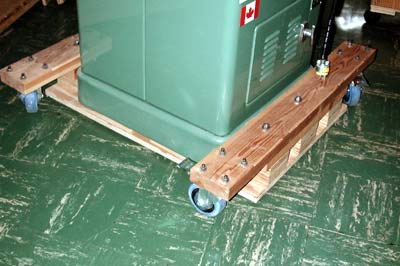
The Spacer Blocks raise the Caster Bearers above the Deck enough
to give about 3/4" of ground clearance under the Deck. The
Spacer Blocks can be pieces of 3/4" plywood about 4"
long, and the same width as the Caster Bearers. With the 4"
Guitel Casters I used, I found that I needed a total Spacer Block
height of 3-3/4". I drilled a 9/16" hole at the center
of each piece to be used in the Spacer Block stacks.
I cut my Caster Bearers from 2x6" fir. On the tablesaw dolly
I made them 4-5/16" wide. On my jointer dolly, I made the
Caster Bearers 3-3/4" wide. I drilled the holes in the right
places in the Caster Bearers using a spade bit or brad point drill,
then clamped the Caster Bearers to the Deck, and match drilled
the bolt holes in the plywood Deck. For each hole, I stopped just
short of going right through the material with the drill, flipped
the part over, and finished the holes from the opposite side.
This prevents splintering on the exit side of the holes.
Once the Dolly was assembled, I shortened the carriage bolts
so they were showing only 2 or 3 threads above the nuts. After
hack sawing them off, I rounded the ends off nicely with a file.
It is also a good idea to pass a file over the sharp edge of the
first turn of the thread so it will not cut your hand at some
later date.
An alternative arrangement, which I have not tried, but which
should work just as well, and give a neater appearance, would
be to substitute T-nuts on the underside of the Dolly Deck, and
run 3/8" hex head bolts down from the top side of the Caster
Bearer. Once you had everything bolted down tight, you could withdraw
one bolt at a time, and saw them off just proud of the T-nuts.
The Guitel casters are mounted to the Caster Bearers with 4 hex
head bolts per caster. I used 5/16" bolts with the nuts and
washers on top of the Caster Bearer, same as for the 3/8"
carriage bolts. This of course does not look quite as nice as
if one had the nuts and washers on the underside, but if installed
that way, the nut and the end of the bolt may foul the rotating
part of the caster frame.
I laid out the 16 holes for mounting the casters to the Caster
Bearers using a combination square as a depth gage. I marked out
one set of 4 caster hole locations with a caster clamped to one
Caster Bearer, then set the combination square to my layout lines,
and transferred everything to the other 3 caster locations. I
drilled a 3/8" hole at each hole location. Done this way,
it goes pretty fast, particularly if done on a drill press.
Note: Make your Caster Bearers long enough so that the casters
are out far enough from the Deck and spacer block that the caster
frame can rotate! With the 4" Guitel casters I used, this
distance needs to be about 5-1/2".

On my jointer dolly, I was able to reduce that to 4-½",
as shown in the drawing below:
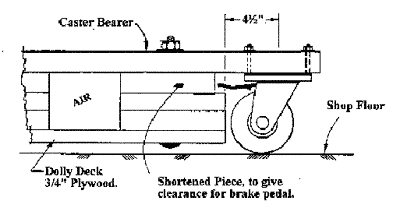
Check carefully how much space to allow for caster clearance
both with respect to the Dolly and the item that will sit on the
Dolly.
- 30 - |

